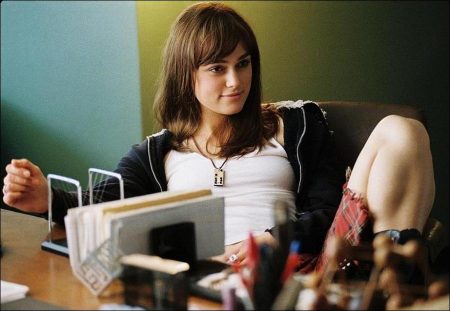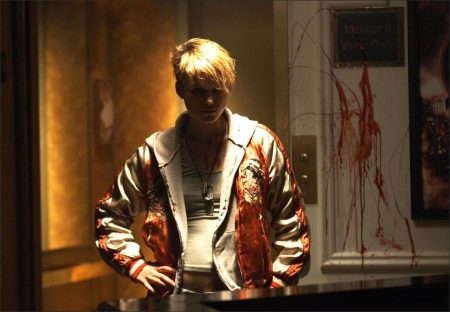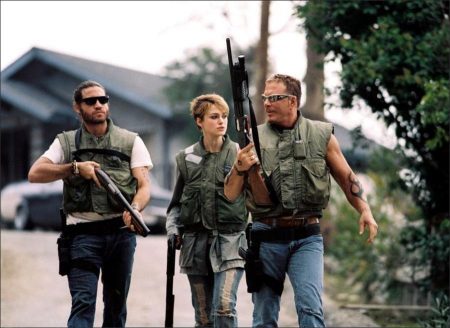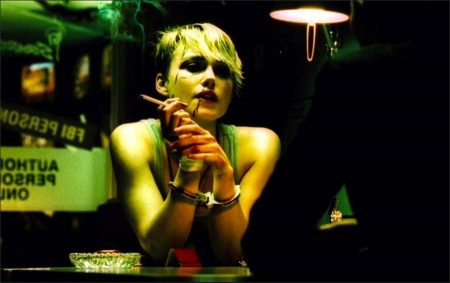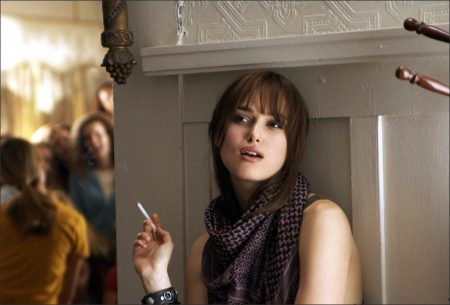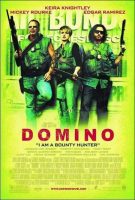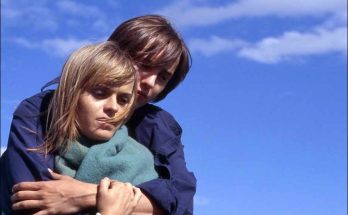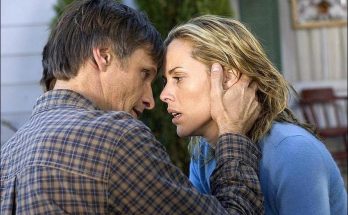Domino Movie Trailer. Director Tony Scott has had a lengthy history with Domino. He first met his muse, Domino Harvey, more than ten years ago after his business manager, Neville Shulman, sent him an article from what Scott refers to as a “rag newspaper” in London. The article depicted the life of a young woman who had decided to become a bail recovery agent and follow the seamier side of life, both personally and professionally. But what really piqued both men’s interest was the fact that this young woman was actor Lawrence Harvey’s (The Manchurian Candidate) daughter, from a very privileged and gentrified background.
Scott immediately got in touch with the then-20-year-old. He invited her to his office and a week later, the two were in discussions to put a version of her life story on screen. The director always planned to begin with an outline of Domino’s life, but from the start never intended to produce a strictly biographical piece. In some cases, he even shied away from using people’s real names “because I was misrepresenting what had actually happened in their lives,” the director says.
Over the years Domino became a surrogate daughter to Scott. He attempted to watch over her and her comrades as best he could, but even the most concerned and involved father cannot always dissuade his children from foolhardy pursuits and destructive behavior.
“I kept telling Domino, ‘You’re crazy,’” Scott recalls. “She was into lots of dangerous things other than bounty hunting, and I said, ‘Watch out. You’re gonna kick down one too many doors.’ But she said through those doors with a shotgun in her hand was the biggest adrenaline rush she’d ever had, and it helped to quell the voices in her head, so there was nothing I could say or do that would change her attitude.”
“When I met Domino, she was living at home in Beverly Hills with her Mum and stepfather, Peter Morton, the famous restaurateur. She’d leave her guns in the garage and pick them up when she went on these bounty hunting missions. She was living two distinctly different lives.”
He cast 20-year-old Keira Knightley from gut instinct. “Domino and Keira are different personalities to be sure,” the director says. “The real Domino was darker, a little more out there, but on the surface they are both English girls – a little innocence, a little Princess Di mixed with discomfort at being slotted into that role. They both come from a different planet that does not mix well with the dark world of bounty hunting. I could see Keira as that girl. Taking Keira on this journey of being Domino Harvey was akin to how the real Domino felt when first being exposed to this dark world.”
Scott first saw Knightley in longtime friend Jerry Bruckheimer’s Pirates of the Caribbean, while Hadida knew her not only from Pirates but also from other roles including Bend it Like Beckham (which he distributed) and Love Actually.
“Keira’s an actress on the rise,” says Hadida, “and Tony was adamant that we should not miss her. Keira has the innocence, the charisma and the presence we wanted. We decided we couldn’t make the movie without her. It was a no-brainer. Although her schedule did put us under some pressure,” he explains, “I believe that you need pressure to make a good movie. It adds energy to the set.”
In April 2004 Knightley made a whirlwind trip from London to L.A. for a breakfast meeting with Scott. “I absolutely loved the script,” she says. “It’s such a mad story; it’s got action, sexuality, violence, bad language…but it’s very funny. I wanted to meet the people behind that dark sense of humor and I was excited by the prospect of doing something a little crazy that I hadn’t done before. Meeting Tony was a thrill; he is so excited by life and by what he does that it’s catching.”
Knightley is quick to point out that her portrayal is not an imitation of the real Domino; rather the actress drew from the film’s real-life muse for inspiration. “There is no point in doing an accurate characterization unless the entire story is accurate,” she says. “So that gave me a lot of freedom to explore the mentality of someone who comes from a privileged background and decides to go off on her own path, in a completely opposite direction. She had a strong rebellious streak. I found the combination fascinating. And even though Domino knew that we were not one hundred percent faithful to her story, I hope she would have liked what we created.”
The film version of Domino Harvey’s life takes license from the very beginning. In Scott’s version her mother and sister first move from London to Los Angeles in 1990. It is not an easy move for the youngster who misses her father, the only one with whom she had ever shared a strong connection. She grows up as the quintessential middle child, not sure of where she belonged or where she was going. After many awkward ups and downs, Domino finds a place where she fits in and even excels. It is not the life her mother would have chosen, but it is where she finds acceptance and love, and how director Tony Scott and much of the world see her.
Scott and screenwriter Richard Kelly begin with a look at Domino’s early years in England in order to capture the intense vulnerability of the girl at the core of the story.
“Domino is tough on the surface, toting guns and kicking down doors,” says Scott, “but underneath, she is this vulnerable girl. She got lost along the way after her dad died, and even though there was a lack of connection to her mother, there is genuine emotion and a relationship of sorts that keeps Domino returning home time and again. You need to see that in order to understand the woman.”
Scott, who is the father of five-year-old twin boys, gets a kick out of working with kids, and especially enjoyed the scenes with Tabitha Brownstone, who portrays eight-year-old Domino. “Tabitha was spunky and feisty,” he says. “She felt like an extension of Keira. I love the challenge of being able to get a performance out of kids, to get the kids to be real. In Hollywood there is a danger that children are over-coached and a little too predictable.”
Precocious, to be sure, Brownstone captured Domino’s discomfort in her own skin. She was quite literally a fish out of water. A tomboy and misfit, her only remaining link to her father is a small goldfish which, like the girl herself, does not survive the boarding schools or other efforts made by her mother to encourage Domino to fit in among her peers and the proper social set.
International actress Jacqueline Bisset appears as Domino’s mother, Sophie Wynn [a pseudonym]. In the 1970s Bisset was acquainted with Domino’s real mother, an elegant, sophisticated woman who had lived an idyllic life with her handsome actor husband.
They were among the beautiful and famous, appearing on the covers of magazines worldwide. Since that time, Domino’s mother has remarried and lives a quieter but no less elegant life style. In spite of their vast differences, mother and daughter stayed in touch and were closer in the last several years of Domino’s life, but unfortunately their schedules did not permit them much time together.
Even after Bisset spoke with Domino’s mother to make certain she was aware of the film and the fictional nature of the story, she was still protective of the character. “I felt tied to my loyalty to Domino’s mother,” says Bisset, “because the situations was a bit delicate. There’s always a sense of responsibility when a character starts from the position of a real person, especially when that person finds herself in an extraordinary circumstances. She is totally worried about the danger in which her daughter finds herself and she can’t imagine what the job entails. Your mind boggles at what can happen.”
“She wants her daughter to be happy,” continues Bisset. “Most mothers do. But she realizes from the very beginning that her daughter is rebellious. She’s grungy, she’s tough, she’s independent. And I ‘m sure Sophie’s youth was not saintly. Becoming a bounty hunter is about getting attention. It’s natural.”
“We depict Domino’s difficult relationship with her mother,” Knightley says. “She isn’t someone who fits in easily with her mother’s crowd. She’s also not someone who cares much about the superficial world of fashion and manicures and hair styling. Her life’s journey is about excitement and finding something that makes her feel alive. She doesn’t find that until she starts bounty hunting and meets a group of people who scare her and intrigue her all at the same time.”
“What makes her good at bounty hunting is her innate ability to remain calm and not flinch while a gun is pointed in her face,” Knightley continues to explain. “Instead of freaking out or becoming hysterical, she becomes eerily calm. She’s a bad ass.”
Once Scott began the casting process, he realized he needed a sound foundation from which his characters could grow and decided that the family aspect of the trio was the place to start. Meeting and researching real bounty hunters proved to be an unlikely but incredibly fruitful well of information for Richard Kelly’s rewrites.
“Most of these guys come from dysfunctional families,” reports Scott. “It’s similar to the Hell’s Angels. The only family connection they know is the one they forge with their selfselected, self-made group.”
“Domino, Ed and Choco were a dysfunctional family that worked,” he continues. “And it all came from Domino, who was searching for a father figure, and somehow Ed became that. They gravitated together because the family they created was the first real family any of them had ever known and addressing these family issues made all the characters much stronger.”
“I always find role models for my actors in real life, and then I try and find actors who are those characters,“ says Scott. “Mickey Rourke was Ed and Edgar Ramirez was Choco. Ed was from Los Angeles and Choco was from El Salvador, but they were like brothers.” Scott, who has known Rourke socially since the director first emigrated to the United States more than 25 years ago, is confident that he cast the perfect man for the role. He remains one of Rourke’s biggest fans and believes in his talent with complete vigor.
“Mickey is a consummate actor,” asserts Scott. “If you look at the main body of his work, anyone can see that he is brilliant at his craft. I honestly believe I cast the right guy and the rest will take care of itself.”
“Ed would sit on one end of the sofa and in my mind I could see Mickey on the other,” the director continues. “They are so similar in personality and character. Mickey is the right age, he’s grown up on motorcycles and in a boxing ring; everything in his life experience just crossed the Ts and dotted the Is in terms of Ed’s character.“
When Rourke heard that Tony Scott wanted him for another film, he agreed without hesitation. “I love Tony Scott,” he says. “He’s a cut above most directors in Hollywood. He’s an actor’s director; he can bring you right to the edge. And I like the movies he makes.”
“The script didn’t really come alive for me until Tony, Keira, Edgar and I started working together,” explains Rourke of his process. “We sat in a room and discussed how we saw the characters beyond the obvious facts that Domino is a girl from London who decides to be a bounty hunter, and Choco is a hot-tempered Latin, and Ed is a godfather character.”
Rourke worked tirelessly with Scott throughout the entire production, constantly refining and polishing his character. He wanted to know the details of Ed’s back-story so that he could understand why this man was driven to take on the central role in this ragtag family.
“I remember years ago when I was a kid there was a bounty hunter movie or television show starring Steve McQueen,” Rourke recounts. “He was somebody who sometimes operated just outside the law, quite a romantic figure. But when you meet the real thing, you find that bounty hunters are quite the contrary. I tried to give Ed some of the reality and some of that romantic quality with an edge.”
The filmmakers found Edgar Ramirez, who portrays Choco, on a lark. He flew into Los Angeles in September of 2004 for a quick meeting with his U.S. representatives before introducing a screening of his film, Punto Y Raya, to the Hollywood Foreign Press Association. Only in town for four days, casting director Denise Chamian suggested that Scott and Hadida meet the young Venezuelan actor.
“We watched part of Punto Y Raya, a contender for Oscar consideration for Best Foreign Language Film,” says Hadida. “After two minutes we stopped and decided to meet Edgar in person because the character he was playing was so different from what we needed, but Tony could already see something. The minute Tony met him I think he knew Edgar had very big potential, and his screen test confirmed it. Tony knows how to find stars when they’re just starting out. Look at all the people he’s cast, from Tom Cruise in Top Gun to Patricia Arquette, Brad Pitt and James Gandolfini in True Romance. He has an eye for talent.”
Domino (2005)
Directed by: Tony Scott
Starring: Keira Knightley, Christopher Walken, Jacqueline Bisset, Mena Suvari, Lucy Liu, Edgar Ramírez, Mickey Rourke, Macy Gray, Brian Austin Green, Mo’Nique, Dabney Coleman
Screenplay by: Richard Kelly
Production Design by: Chris Seagers
Cinematography by: Dan Mindel
Film Editing by: William Goldenberg, Christian Wagner
Costume Design by: B. Åkerlund
Set Decoration by: Nancy Nye
Art Direction by: Drew Boughton, Keith Neely
Music by: Harry Gregson-Williams
MPAA Rating: R for strong violence, pervasive language, sexual content / nudity, drug use.
Distributed by: New Line Cinema
Views: 233
